
Recently on Cyclingnews.com |
Eurobike show
Friedrichshafen, Germany, September 4-7, 2008
Main Page Previous Part Next Part
Off-road machines from Eurobike
By Matt Skinner, What Mountain Bike
Giant's more versatile Anthem X
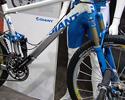
|
Following on from last year's additions to the Trance and Reign lines with the X models, this year sees the turn of the Anthem race bike getting an extra travel option.
The Anthem X sees Giant boost the travel on its premier race bike platform from 3.5" to a full 4" and front travel is increased to match as well. Along with the slightly slacker 71 degree head tube angle, Giant hopes the Anthem X will satisfy the rider looking for fast and efficient XC/trail miles, but without the pure race focus and ultra-fast handling of the original Anthem.
Giant also subtly rearranged its excellent Maestro suspension system to accommodate the extra travel with the shock now being mounted vertically into the downtube/bottom bracket area as it is on the Trance and Reign platforms.
The well-equipped Anthem XO will top the Anthem X range but all models will use an aluminum frame - at least for now. A carbon model will likely appear next season but for now, the existing Anthem Advanced will continue as Giant's top race bike and the Anthem platform itself remains in the range for 2009.
What Mountain Bike magazine will have a full and exclusive test of the new Anthem X in its forthcoming issue - WMB89, on-sale 15th October.
Marin turns lead to gold
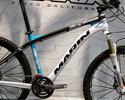
|
Marin impressed hugely in 2008 and its 5"-travel Mount Vision trail bike won What Mountain Bike magazine's prestigious Bike of the Year award. Historically, however, the Mount Vision was a lightweight, 4"-travel cross country bike that could take on both the race course and the trail centre. With the shuffling up in travel and an increase in weight for increased trail bike strength this left a hole in Marin's line for a lighter, more XC-focused bike. Enter for 2009 from stage left, the Alchemist.
Made from hydroformed 6066 aluminum, the Alchemist is a 4" XC/marathon bike that Marin claims is the lightest and stiffest it's ever made, and uses an evolution of its established Quad Link XC suspension system. The updated suspension system - Quad Link XC 2.0 - supports a shorter stroke shock and a radically designed frameset from previous Quad Link bikes. A descending top tube forms the top pivot and shock mount, whilst a seat mast forks off to join the seat tube to create a distinctive 'V'-shaped top tube profile for massive stand-over. Forged pivot mounts increase weight and strength and the wide lower link is offset 4mm to the non-drive side for greater crank clearance. Geometry is also changed to suit its speedier credentials, with a steeper head angle and longer top than the Mount Vision. Marin claims the new bike weighs an on-the-money 9.9kg (21.8lb).
Marin has also joined the growing legion of companies with a full carbon hardtail in its range. The new CXR Team is designed as an out and out race bike with ultra-light weight and category-appropriate rigidity. The reinforced head tube helps keep the front end tracking straight while its curving lines and internal cable routing also give it striking road bike looks.
Merida expands Ninety-Six range
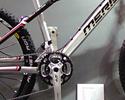
|
Following on the heels of the Ninety-Six Team D carbon race bike built for the Beijing Olympics - all £7000 of it - Merida has launched a full 96 line that includes more accessible aluminum versions.
The Ninety-Six HFS 3000-D is one of two aluminum bikes in the line that will be available in the UK (US residents will have to be more <i>creative</i> the less expensive HFS 1000-D will feature a more value-oriented spec. Both feature the same HFS aluminum mainframe with carbon seat stays and a custom X-Fusion RC shock, but the 3000-D gets a Fox F100 RL fork, XT drivetrain and Magura Louise brakes. The 1000-D sees a Manitou R7 Super Air fork, XT/SLX transmission and Shimano M575 hydraulic disc brakes. For the UK, both these bikes will come with riser bars rather than the straight flat bars that will feature on the European versions.
Pricing of both these bikes has yet to be confirmed, although we expect them to be around the £2000 mark.
New for 2009 is the addition on Merida's higher end One-Five-O and TransMission trail bikes - including the TransMission HFS 3000-D (pictured) - of a floating brake mount to combat the negative effects of braking forces on the bike's suspension action.
The design is Merida's own and features a carbon arm running from just behind the bottom bracket to the forged aluminum brake mount assembly. It's not groundbreaking or revolutionary, but it should enable Merida's trail bikes - that use an essentially single-pivot suspension design - to perform to their best potential.
Rocky Mountain heads skywards
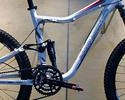
|
Rocky Mountain has put out to pasture its long running ETSX bikes: in their wake comes the enigmatic Altitude platform.
Designed as a bike for "epic cross country riding," the Altitude is a 140mm (5.5") - travel bike that has stepped into a very bright scrutinizing spotlight right from the off. Not only is the Altitude a maverick rendering of active geometry for greater performance on all trail situations, but its suspension design could ruffle some big feathers.
The bike itself has been created for big days of trail riding in the back country: robust and with a relatively low 2.4:1 shock ratio and a slightly rising rate, it's designed to offer a bottomless suspension feel. Rocky Mountain says the Altitude suspension design is an evolution of the ETS (Energy Transfer System) used on the ETSX bikes and that the new platform operates within the patent. But on face value it is a true four-bar and the key question is whether or not the rear pivot infringes on Specialized's fiercely defended Horst Link patent.
On the Altitude, the rear pivot is around 5mm above the rear axle line whereas on Specialized's FSR and FSR licensed designs, the pivot is below or inline with the rear axle. However the past few years has seen the pivot points on many designs - FSR or not - move further towards the rear axle in a gradual trend of refinement. Rocky Mountain obviously feels confident that its design does not infringe on Specialized's patent, and if this is secure ground, it could birth a slew of designs as other manufacturers follow suit.
And now for the maverick bit: In order to maximize the bike's performance both up and down hill, the head tube is on the money at 69 degrees but the static seat angle is a super steep 76 degrees. When the rider sits on the bike and the suspension sags into active geometry, the angles will then change and, so goes Rocky's thinking, the rider will be in the optimum position for climbing. It's an interesting theory but one we can't comment on fully until we get a bike in for test and put it through its paces. Look out for the exclusive first test in a forthcoming issue of What Mountain Bike magazine.
The Altitude will come in three carbon versions with a claimed frame weight of 2.49kg (5.5lb), and two aluminum which are about half a kilo (1lb) heaver. On all bikes the attention to detail is impressive: the S-curved down tube leaves enough room for a bottle (or battery) in the main triangle and there is a second set of bottle bosses on the underside of the down tube. The kink also allows for a piggy back shock and a similarly kinked top tube gives a large stand-over clearance.
On the carbon frames, the underside of the down tube has been profiled to help deflect rocks from the frame by glancing off the tube rather than smacking straight into it; the rocker is all carbon save for the aluminum bearing inserts; and an integrated seat clamp design is being finalized.
Salsa Cycles' new Fargo
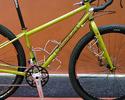
|
Following on from Salsa's recent launch of two new full suspension trail bikes - the Big Mama and the El Kaboing - the Minneapolis based brand unveiled more complete bikes to grow its range still further. Arguably the biggest eye catcher was its distinctive adventure tourer, the double-butted cromoly steel Fargo.
On face value, the Fargo is a mule of a bike combining 29er mountain bike wheels that can fit up to a 2.4" tyre, drop bars, full rack and pannier fixings, cable disc brakes and no fewer than five bottle cages. But its attention to detailing is first rate: its custom post mount disc tabs on the frame is just one example and they're tucked out of the way so as not to interfere with pannier loads.
Geometry sits at 70 degree head angle for most sizes, mated with a 73 or 72 degree seat (depending on frame size) that Salsa say is designed for loaded touring on singletrack, gravel, asphalt, and anything in between. A low bottom bracket also aids heavy loaded stability.
Photography
For a thumbnail gallery of these images, click here
Images by Matt Skinner
- Giant's new Anthem X looks to keep most of the standard Anthem's racy personality but toned down a bit with more travel and slightly more docile handling.
- The Anthem X's Maestro suspension layout has been revised a bit to accommodate the extra travel.
- Marin's new Alchemist looks to be a star in the 2009 lineup with light weight and relatively short travel.
- The Alchemist's dual-link suspension design is an evolution of Marin's existing Quad Link XC layout.
- Marin will also bring a carbon hardtail race bike to the range for 2009.
- Clearances look to be rather tight at the seat stays for the new CXR.
- The well reinforced head tube sports internal cable routing.
- Merida's über-expensive Ninety-Six Team D now has less expensive aluminium cousins.
- Merida has added a clean-looking floating disc brake mount to its higher-end One-Five-O and TransMission trail bikes.
- Any negative braking effects on the TransMission's faux-bar rear end should mostly be eliminated with the new brake mount.
- Rocky Mountain's new Altitude Carbon looks to be winner… as long as the patent lawyers don’t interfere.
- Carbon, carbon everywhere.
- The Altitude Carbon's carbon rocker arm features sealed cartridge bearing pivots all around.
- Rocky Mountain still has to work out the final design but the carbon Altitude frames will apparently use an integrated seat binder design.
- The Rocky Mountain Altitude 50's kinked down tube leaves plenty of room for a water bottle in the main triangle.
- Rocky Mountain claims the Altitude's suspension design doesn't infringe on Specialized's Horst Link patent but we're not so sure.
- Salsa showed off its new Fargo do-everything MTB tourer that has room for monster 29" tires and comes with a full complement of rack, fender and bottle fittings.
- The post mount disc tabs are set within the rear triangle to keep them away from panniers.
